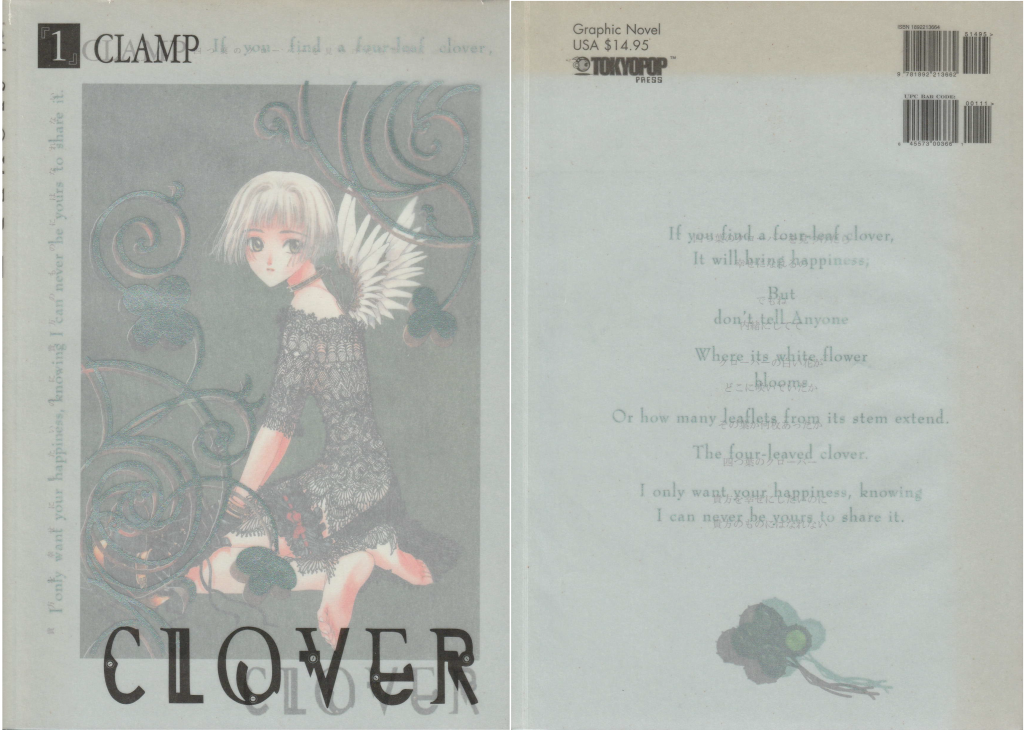





…starts with one step. In the “A Thousand Miles” series, I’ll be taking a series each week that looks interesting to me and reviewing the first volume. Focused on, essentially, exposing myself to as many new series as possible, each will culminate in whether I think it’s worth continuing.
****
Clover is a 1997 fantasy manga by manga group, CLAMP. Originally published in the Shoujo Amie Magazine, it would reside there until the publication’s termination in 1999, leaving the work unfinished. Madhouse created an animated music video that opened for the Cardcaptor Sakura movie (another CLAMP work) in japanese theaters in 1999. Tokyopop released four volumes in the west starting in 2001. Dark Horse would later release the series in an omnibus edition in 2014.
: There are at least two releases of this work. I’m working from the first volume of the Tokyopop run.

Damn, that’s fancy – I don’t know if every copy of volume one (or the other three, for that matter) has this, but mine has a low opacity sleeve that transcribes English translations and some clover imagery onto the original cover. It makes for this delightful fade effect and it’s probably the fanciest thing I’ve seen short of an artbook.
Dat Poety – When you need to set up a theme in a hurry, poetry is the way to do it. I’m not going to print the whole thing. Aptly themed, our poem (which stands in for the back cover description) is about a four leaf clover and its ability to bring you happiness, but with the admonition to tell no one about it – all capped off with a declaration of desire for another’s happiness despite their inability to share in it. It’s a great primer for the work as the main theme, more so than love or happiness, is isolation.
Owing favors can be a bitch, sometimes. Kazuhiko, now a civilian learns this the hard way when one of his old supervisors, General Ko, conscripts him to escort a mysterious girl, Sue, to an unknown location. Needless to say, she’s in high demand. So where exactly is Sue supposed to be going and just what is so special about her?
Kazuhiko Fay Ryu – Retired Black Op, possibly due to his escapades and the multiple court martialings. Has a transforming arm that can manifest a blade.
Sue – Mysterious little girl put in Kazuhiko’s care. Calm and observant, she’s rather fixated on one particular song by an in-universe artist, Ora.
General Ko – Kazuhiko’s old superior that puts him up to escorting Sue. Not much is known about her, but she must be important if she can pull the strings that she has.
Gingetsu – Commander and associate of (if not friend) of Kazuhiko. Is still on active duty and helps Kazuhiko in a pinch.
General Bols – An old acquaintance (read: enemy) of Kazuhiko. Seems to enjoy taunting and hurting him. Is presently after Sue.
Now, you’ve likely noticed that the Gist for this work was mighty short. That’s because the story (so far) is rather simplistic. It’s an escort mission – and, logistically speaking, a kinda crappy one at that. Kanzuhiko doesn’t even know where he’s supposed to be taking Sue. But neither do we as the audience. Many a story has benefited from having at least two plot threads or different perspectives on different portions of the work’s chain of events. Clover suffers from relying too heavily on just one. The universe clover happens in has many interesting things in it, but we’re glued to Kazuhiko and Sue too much to capitalize on it. Later volumes likely cover that but volume 1 feels like the low poly model of a much better looking story – I hope.
To that end, what Clover is more successful at is its symbolism and thematic conceit. As previously stated, isolation is the standout theme. Sue is the lynch pin in Clover’s depiction of this as she seems to have no friends or family (she heavily implies as much). We don’t know much about her, which creates a disconnect between her and the audience. The same can be said about Kazuhiko, but to a lesser degree. A four leaf clover, which Sue is referred to as, is commonly held as lucky, but highly rare – making it an apt symbol. The panel layout compliments this with its array of small tile-like squares and vast amount of open, empty space. Combine that with the fact that said panels are filled, more often than not, with just Kazuhiko and Sue, usually trying to get the slightest bit of information out of their traveling partner and you get a rather lonely experience.
For what it’s worth, Clover is not all bad. The art style is rather ornate. I’ll never get over how lanky some of the characters are, but the sci fi designs here are nice. Clover is a bit of a mixed bag because it front loads its presentation with symbolism and poetry – so much poetry. There’s a poem on the back cover, a portion of that on the front cover and then the full thing on the inside cover. Even the table of contents looks like a poem, in a “Waters of March” kind of way – so much so that I didn’t realize it wasn’t one for a while. The issue then, is that what follows doesn’t provide enough plot, per se, to spread all of that poetic symbolism jam over. Therefore, the plot’s lack of excitement makes for an underwhelming experience. However, despite that, Clover’s insistence on focusing on the minutiae of Kazuhiko and Sue trying to feel each other out and Sue’s stewing in her own melancholy does a fantastic job of supporting the isolation theme.
To be blunt, I’m neither convinced that Clover is going to do anything clever or intriguing with the rougher elements of its plot, nor am I interested enough to stick around to find out.
Continue?:



